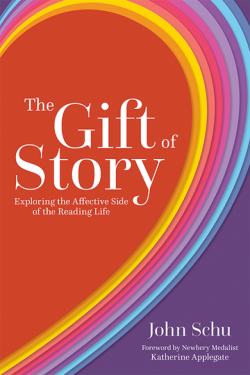From The Gift of Story by John Schu, © 2022, reproduced with permission of Stenhouse Publishers. www.stenhouse.com. No reproduction without written permission from the publisher.
Every child who walks into your classroom or library has a story. But how do we establish opportunities for them to tell their stories and find themselves in the stories of others? When we share our hearts in authentic ways, we inspire those around us to do the same. Before we can discuss what it means to share our hearts through story, it might be helpful to establish what we mean by the word story. If you think about it, the way a third-grade teacher defines story is probably different from how a music teacher defines story. The way a music teacher defines story is probably different from how a teacher-librarian defines story. And the way a teacher-librarian defines story is probably different from how a fourth grader defines story. Since we all have our own personal definitions of the word, take a moment to reflect on how you define story.
 Perhaps your definition brings to mind story elements like main idea, theme, characters, setting, and plot. These are all very important in the literacy work we do with children, but we can expand our idea of story as we consider other elements that may not be immediately evident—such as joy, happiness, compassion, laughter, connection, culture, and identity. For our purposes, we’ll apply a flexible definition that makes room for story to meet both the academic and affective needs of our students. Sharing your heart through story is a way to bring more of the affective side into our students’ reading lives.
Perhaps your definition brings to mind story elements like main idea, theme, characters, setting, and plot. These are all very important in the literacy work we do with children, but we can expand our idea of story as we consider other elements that may not be immediately evident—such as joy, happiness, compassion, laughter, connection, culture, and identity. For our purposes, we’ll apply a flexible definition that makes room for story to meet both the academic and affective needs of our students. Sharing your heart through story is a way to bring more of the affective side into our students’ reading lives.
When we share our hearts through story, we create environments in which children can feel warm and safe and loved. I’ve witnessed again and again how students open up their hearts to teachers and each other when we share how a story allowed us to view the world in new ways, healed our hearts, and inspired us to take action. As we further refine our understanding of story, we’ll bring our lens into deeper focus on its affective elements.
Story as Clarifier
This helps us individually and in groups answer questions about our heart’s deepest wonderings and passions. Think of the animal lover who checks out every caring for a pet book or the junior historian who can’t get enough of Kate Messner’s “History Smashers” series.
Story as Healer
This helps our heart work through difficult experiences as well as internal and external conflicts. Think of the child who deals with the loss of a grandparent by reading Caron Levis and Charles Santoso’s “Ida, Always” every day or the middle schooler who, after reading Jen Petro Roy’s “Good Enough,” admits to himself and a family member that he has an eating disorder and needs help.
Story as Inspiration
This helps us explore and discover our passions. Think of the child who folds hundreds of origamis after reading Tom Angleberger’s “The Strange Case of Origami Yoda” or the child who becomes an activist for something important to them after reading “Marley Dias Gets It Done: And So Can You.”
Story as Compassion
This helps us understand ourselves and others. Think of the child who develops more empathy after reading Jacqueline Woodson and Rafael López’s “The Day You Begin” or the adolescent who comes to terms with her sexuality after reading Ashley Herring Blake’s “Ivy Aberdeen’s Letter to the World.”
Story as Connector
When Kate DiCamillo was the National Ambassador for Young People’s Literature, she said, “Together, we see the world. Together, we see one another. We connect. And when we connect, we are changed.” Stories answer this call by helping us open our hearts and connect. Think about times when everyone in a community comes together to celebrate a book or when every fifth grader has tears running down their faces after their teacher reads aloud the last sentence in John David Anderson’s “Ms. Bixby’s Last Day.”



